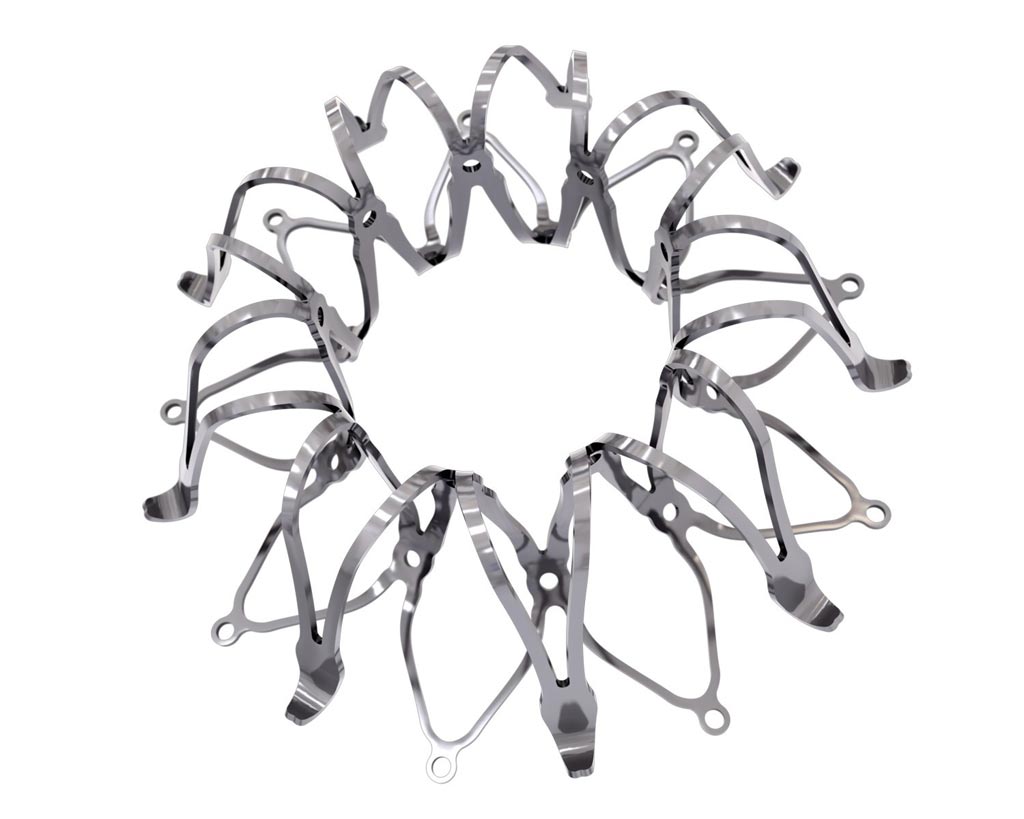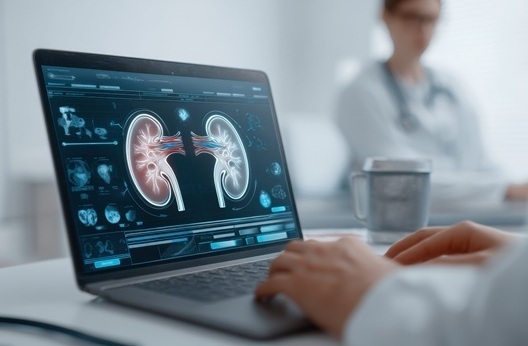Interatrial Shunt Helps Decompress Failing Heart
|
By HospiMedica International staff writers Posted on 24 Oct 2019 |

Image: The Corvia InterAtrial Shunt Device (IASD) (Photo courtesy of Corvia Medical).
A novel implantable cardiac shunt helps treat heart failure (HF) patients with preserved and mid-range ejection fraction.
The Corvia Medical (Tewksbury, MA, USA) Interatrial Shunt Device (IASD) is an innovative transcatheter implantable device designed to help diastolic HF function by forming a channel that connects left and right atria, thus facilitating continuous and dynamic decompression of the left atrium and enabling it to relax at rest and physical activity. Once in place, a permanent passage is created in the septum between the atria, resulting in reduction in HF symptoms, improved quality of life, and reduced hospitalization rates.
The IASD, which has been granted “Breakthrough Device” designation by the U.S. Food and Drug Administration (FDA), is being studied in the REDUCE LAP-HF II study, a large multi-national prospective, double-blind, sham-controlled trial randomizing 608 HFpEF and HFmrEF patients in the United States, European Union, Australia, Japan, and Canada. One-year follow-up data of the IASD clinical study, held in 64 patients implanted at 18 centers, demonstrated shunt patency for all participants who received the implant.
“Receiving Breakthrough Device designation from the FDA underscores the significant unmet need for more effective treatment options for heart failure patients,” said George Fazio, President and CEO of Corvia Medical. “We look forward to continuing our work with the FDA through our ongoing pivotal trial in more than 100 hospitals, and providing the clinical evidence which will accelerate the timeline to bring the IASD to the U.S. market.”
There are two types of HF; HF with reduced ejection fraction (HFrEF, systolic heart failure), and heart failure with preserved or mid‐range ejection fraction (HFpEF/HFmrEF), previously called diastolic heart failure. HFpEF accounts for approximately 50% of all HF, but treatment options are limited, consisting mainly of diuretics and fluid balance control. Although the pathophysiology of HFpEF is complex, many of the symptoms are a result of excessive rises in left atrial pressure, in particular during exercise.
Related Links:
Corvia Medical
The Corvia Medical (Tewksbury, MA, USA) Interatrial Shunt Device (IASD) is an innovative transcatheter implantable device designed to help diastolic HF function by forming a channel that connects left and right atria, thus facilitating continuous and dynamic decompression of the left atrium and enabling it to relax at rest and physical activity. Once in place, a permanent passage is created in the septum between the atria, resulting in reduction in HF symptoms, improved quality of life, and reduced hospitalization rates.
The IASD, which has been granted “Breakthrough Device” designation by the U.S. Food and Drug Administration (FDA), is being studied in the REDUCE LAP-HF II study, a large multi-national prospective, double-blind, sham-controlled trial randomizing 608 HFpEF and HFmrEF patients in the United States, European Union, Australia, Japan, and Canada. One-year follow-up data of the IASD clinical study, held in 64 patients implanted at 18 centers, demonstrated shunt patency for all participants who received the implant.
“Receiving Breakthrough Device designation from the FDA underscores the significant unmet need for more effective treatment options for heart failure patients,” said George Fazio, President and CEO of Corvia Medical. “We look forward to continuing our work with the FDA through our ongoing pivotal trial in more than 100 hospitals, and providing the clinical evidence which will accelerate the timeline to bring the IASD to the U.S. market.”
There are two types of HF; HF with reduced ejection fraction (HFrEF, systolic heart failure), and heart failure with preserved or mid‐range ejection fraction (HFpEF/HFmrEF), previously called diastolic heart failure. HFpEF accounts for approximately 50% of all HF, but treatment options are limited, consisting mainly of diuretics and fluid balance control. Although the pathophysiology of HFpEF is complex, many of the symptoms are a result of excessive rises in left atrial pressure, in particular during exercise.
Related Links:
Corvia Medical
Latest Critical Care News
- Miniature Non-Invasive Robotic Catheters to Improve Infertility Treatments
- Stick-On Patch Monitors Baby's Movements In Utero
- EEG-Based AI Technology Accurately Diagnoses Alzheimer’s and Dementia
- Robot Lymphatic System Paves Way for Self-Powered Wearables and Machines
- Focused Ultrasound Technique Successfully Treats Pediatric Brain Cancer
- Nasal Drops Fight Brain Tumors Noninvasively
- AI Helps Optimize Therapy Selection and Dosing for Septic Shock
- Glowing Bacteria ‘Pills’ for Detecting Gut Diseases Could Eliminate Colonoscopies
- Skin-Permeable Polymer Patch Delivers Insulin Non-Invasively Through Skin
- Nanogel Technology Almost 100% Effective in Destroying Drug-Resistant Bacteria Within Hours
- Wearable Ultrasound Sensor Delivers Noninvasive Treatment Without Surgery
- Gel-Free ECG System to Transform Heart Health Diagnosis
- Biodegradable Patch Repairs Damaged Tissue After Heart Attack
- Magnetically Guided Microrobots to Enable Targeted Drug Delivery

- Smart Nanomaterials Detect and Treat Traumatic Brain Injuries Simultaneously
- Earlier Blood Transfusion Could Reduce Heart Failure and Arrhythmia in Heart Disease Patients
Channels
Surgical Techniques
view channelLaparoscopic Surgery Improves Outcomes for Severe Newborn Liver Disease
Biliary atresia is a rare but life-threatening liver condition in newborns that blocks bile flow and leads to progressive liver damage if not treated early. Surgery is typically performed within the first... Read moreNovel Endoscopy Technique Provides Access to Deep Lung Tumors
Detecting lung cancer early can save lives, but diagnosing small tumors deep in the outer regions of the lungs remains a major clinical challenge. Although CT scans frequently identify tiny suspicious... Read morePatient Care
view channel
Revolutionary Automatic IV-Line Flushing Device to Enhance Infusion Care
More than 80% of in-hospital patients receive intravenous (IV) therapy. Every dose of IV medicine delivered in a small volume (<250 mL) infusion bag should be followed by subsequent flushing to ensure... Read more
VR Training Tool Combats Contamination of Portable Medical Equipment
Healthcare-associated infections (HAIs) impact one in every 31 patients, cause nearly 100,000 deaths each year, and cost USD 28.4 billion in direct medical expenses. Notably, up to 75% of these infections... Read more
Portable Biosensor Platform to Reduce Hospital-Acquired Infections
Approximately 4 million patients in the European Union acquire healthcare-associated infections (HAIs) or nosocomial infections each year, with around 37,000 deaths directly resulting from these infections,... Read moreFirst-Of-Its-Kind Portable Germicidal Light Technology Disinfects High-Touch Clinical Surfaces in Seconds
Reducing healthcare-acquired infections (HAIs) remains a pressing issue within global healthcare systems. In the United States alone, 1.7 million patients contract HAIs annually, leading to approximately... Read moreHealth IT
view channel
EMR-Based Tool Predicts Graft Failure After Kidney Transplant
Kidney transplantation offers patients with end-stage kidney disease longer survival and better quality of life than dialysis, yet graft failure remains a major challenge. Although a successful transplant... Read more
Printable Molecule-Selective Nanoparticles Enable Mass Production of Wearable Biosensors
The future of medicine is likely to focus on the personalization of healthcare—understanding exactly what an individual requires and delivering the appropriate combination of nutrients, metabolites, and... Read moreBusiness
view channel
Philips and Masimo Partner to Advance Patient Monitoring Measurement Technologies
Royal Philips (Amsterdam, Netherlands) and Masimo (Irvine, California, USA) have renewed their multi-year strategic collaboration, combining Philips’ expertise in patient monitoring with Masimo’s noninvasive... Read more
B. Braun Acquires Digital Microsurgery Company True Digital Surgery
The high-end microsurgery market in neurosurgery, spine, and ENT is undergoing a significant transformation. Traditional analog microscopes are giving way to digital exoscopes, which provide improved visualization,... Read more
CMEF 2025 to Promote Holistic and High-Quality Development of Medical and Health Industry
The 92nd China International Medical Equipment Fair (CMEF 2025) Autumn Exhibition is scheduled to be held from September 26 to 29 at the China Import and Export Fair Complex (Canton Fair Complex) in Guangzhou.... Read more















